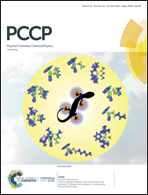Modulating the electronic structures of blue phosphorene towards spintronics†
Abstract
Modulation of the electronic and magnetic structure of blue phosphorene nanoribbons to explore the potential application in spintronics is appealing. Using density functional theory in combination with the non-equilibrium Green's function method, the energetic, electronic, magnetic, and spin-resolved transport properties of hydrogenated armchair and zigzag blue phosphorene nanoribbons with surface modification by 3d transition metal atoms (ranging from Sc to Ni) were systematically investigated. The blue phosphorene nanoribbons were found to be highly capable of adsorbing impurity atoms, and the adatoms prefer a 2D growth mode on the nanoribbons. The band structures of the blue phosphorene nanoribbons were effectively modulated by the adatoms: the bandgap dramatically decreased with remarkable spin-polarization, except in the case of Ni. The spin-resolved transport properties of Sc-adsorbed zigzag blue phosphorene nanoribbons were selectively investigated to explore the potential application in spintronics, and a giant magnetoresistance effect of above 500 was found. This work suggests that the surface adsorption of 3d transition metal heteroatoms is a feasible and effective approach to functionalize blue phosphorene nanoribbons for spintronic applications.



 Please wait while we load your content...
Please wait while we load your content...